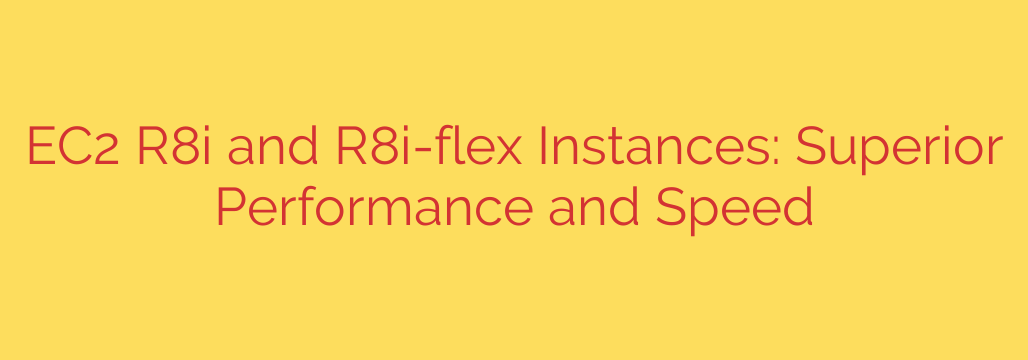
A New Era of Cloud Performance: A Deep Dive into EC2 R8i Instances
In the fast-paced world of cloud computing, the demand for more powerful, efficient, and cost-effective infrastructure is relentless. To meet this challenge, a new generation of memory-optimized instances has emerged, designed to handle the most demanding workloads with unparalleled speed and reliability. Meet the Amazon EC2 R8i and R8i-flex instances, engineered to deliver superior performance for databases, in-memory caches, and real-time data analytics.
Powered by 4th generation Intel Xeon Scalable processors (code-named Sapphire Rapids), these instances represent a significant leap forward. Combined with state-of-the-art DDR5 memory, they provide higher memory bandwidth than previous generations, ensuring your applications can access data faster than ever before. This powerful combination results in a remarkable boost, offering up to 10% better price-performance compared to the last-generation R7iz instances.
Let’s explore what makes these instances a game-changer for your cloud architecture.
Key Hardware and Performance Upgrades
The performance gains of R8i instances are rooted in their cutting-edge hardware. The move to 4th Gen Intel Xeon processors and DDR5 memory is not just an incremental update; it’s a foundational enhancement that directly translates to better application performance.
- Next-Generation Processing Power: The latest Intel Xeon processors provide more cores, higher clock speeds, and advanced instruction sets, enabling faster query processing, quicker data analysis, and lower latency for your applications.
- Faster Memory Access: DDR5 memory offers a significant increase in bandwidth over the previous DDR4 standard. For memory-intensive workloads like in-memory databases (e.g., Redis or Memcached) and large-scale analytics platforms (e.g., Apache Spark), this means data can be read and written much more quickly, eliminating critical bottlenecks.
- Optimized for Demanding Workloads: These instances are specifically built for tasks that require large memory footprints and high computational power. This includes relational and NoSQL databases, distributed web-scale in-memory caches, and big data processing frameworks.
Introducing R8i-flex: Smart Performance for Variable Workloads
While some applications require sustained, peak performance 24/7, many others have variable or bursty CPU usage patterns. Think of web servers, development environments, or batch processing jobs that run intermittently. For these scenarios, provisioning a high-performance instance that sits idle much of the time is not cost-effective.
This is where R8i-flex instances shine. They are a revolutionary, cost-effective variant of the standard R8i instances.
R8i-flex instances are built on the exact same hardware as R8i but are designed for workloads that don’t need full CPU power continuously. They provide a generous baseline of CPU performance with the ability to automatically and transparently burst to full CPU power when your application needs it. This innovative approach delivers an incredible up to 24% better price-performance compared to R7i instances, making them an ideal choice for a wide range of common applications.
R8i vs. R8i-flex: Which Instance is Right for You?
Choosing the right instance is crucial for optimizing both performance and cost. The decision between R8i and R8i-flex depends entirely on your workload’s specific characteristics.
You should choose standard R8i instances for:
- Sustained High-CPU Workloads: Production databases (SQL and NoSQL) that consistently handle high transaction volumes.
- High-Traffic Caching: Large, distributed in-memory caches that serve millions of requests per second.
- Real-Time Big Data Analytics: Continuous data processing jobs running on platforms like Hadoop and Spark.
- High-Performance Computing (HPC): Memory-intensive scientific and financial modeling applications.
You should choose R8i-flex instances for:
- Web and Application Servers: Most web servers experience fluctuating traffic, making them perfect candidates for a burstable performance model.
- Virtual Desktops (VDI): User activity on virtual desktops is typically sporadic, with peaks of activity followed by periods of idle time.
- Development and Test Environments: These environments often require powerful hardware for compiling code or running tests but are not in constant use.
- Batch Processing: Workloads that run on a schedule and require a short burst of intense processing.
Security and Management Built-in
Security is a foundational pillar of modern cloud infrastructure. All R8i and R8i-flex instances are built on the AWS Nitro System, a sophisticated combination of dedicated hardware and a lightweight hypervisor. The Nitro System enhances security by offloading many virtualization, storage, and networking functions to dedicated hardware, reducing the attack surface and providing stronger isolation between instances.
Security Tip: While the Nitro System provides robust foundational security, always follow best practices for your instances. This includes configuring strict security group rules, using IAM roles with least-privilege permissions, and ensuring your operating systems and applications are consistently patched against vulnerabilities.
Getting started with these new instances is simple. They can be launched directly from the AWS Management Console, Command Line Interface (CLI), or through Infrastructure as Code tools like AWS CloudFormation. For existing workloads, consider using AWS Compute Optimizer, which can analyze your current instance usage and recommend if migrating to an R8i or R8i-flex instance would be beneficial.
By offering both sustained high-performance (R8i) and intelligent, cost-effective burstable performance (R8i-flex), this new family of instances provides the flexibility and power needed to build and scale the next generation of applications in the cloud.
Source: https://aws.amazon.com/blogs/aws/best-performance-and-fastest-memory-with-the-new-amazon-ec2-r8i-and-r8i-flex-instances/








